Historic police buildings in Hong Kong
Several police buildings in Hong Kong are listed as historic monuments. While some of them are still serving their initial purpose, most of them have been decommissioned and have been redeveloped or are awaiting redevelopment.
Historic police stations
Historic police stations include:
| Name | Photographs | Location | Notes/References |
|---|---|---|---|
| Old Stanley Police Station | 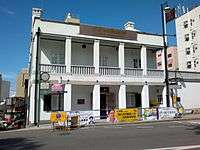 |
22.21831°N 114.213121°E | Built in 1859, a declared monument. Now used as a Wellcome supermarket. |
| Central Police Station | 22.28174°N 114.154196°E | Built in 1864, a declared monument | |
| Former Marine Police Headquarters Compound | 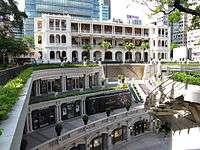 |
22.295479°N 114.169994°E | Built in 1884. Now a heritage hotel with food and beverage outlets, and retail facilities. A declared monument. |
| Peak Police Station | No. 92 Peak Road, The Peak. |
Built in 1886. A Grade III Historic Building. | |
| Old Aberdeen Police Station | No. 116 Aberdeen Main Road, Aberdeen. |
Built in 1891. A Grade II Historic Building. | |
| Old Tai Po Police Station | 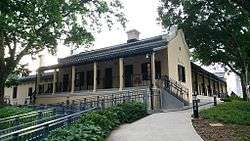 |
22.446422°N 114.169735°E | Built in 1899. A Grade II Historic Building. |
| Old Ping Shan Police Station | 22.446422°N 114.169735°E | Built in 1899. Now used as the Ping Shan Tang Clan Gallery cum Heritage Trail Visitors Centre. A Grade II Historic Building. | |
| Old Tiu Keng Leng Police Station aka. Rennie's Mill Police Station (前調景嶺警署) |
No. 160 Po Lam Road South, Tiu Keng Leng |
Built in 1900. Closed in 1941. Since 1999, it was partially used by the Po Yin Fat Yuen, a monastery founded in 1956, after the original monastery building was torn down with the clearance of the nearby squatter area in 1996. Its function as a monastery ceased in 2015.[1] | |
| Old Tai O Police Station | 22.25322°N 113.853686°E | Built in 1902, a Grade III Historic Building. Converted into a boutique hotel. | |
| Old Sheung Shui Police Station | 22.508248°N 114.125432°E | Built in 1902. Now housing a Junior Police Corps (JPC) Club House. It is a Grade III historic building. | |
| Cheung Chau Police Station | No. 4 Police Station Path, Cheung Chau. |
Built in 1913. A Grade II Historic Building. Still used as a police station. | |
| Lok Ma Chau Police Station | No. 100 Lok Ma Chau Road, Lok Ma Chau. |
Built in 1915. A Grade II Historic Building. Still used as a police station. | |
| Yau Ma Tei Police Station | 22.309676°N 114.168704°E | Built in 1922, a Grade III Historic Building, closed and relocated in 2016 | |
| Sham Shui Po Police Station | 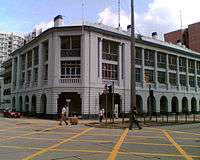 |
22.329986°N 114.159088°E | Built in 1924, a Grade III Historic Building |
| Former Sha Tin Police Station | No. 102 Sha Tin Tau Village |
Built around 1924. Converted into the High Rock Christian Camp in 1980.[2] A Grade II Historic Building. | |
| Old Kowloon Police Headquarters (舊九龍警察總部) |
22.324525°N 114.168835°E | Built in 1925. Now part of the Mong Kok Police Station. Grade II Historic Building.[3] | |
| Wan Chai Police Station | 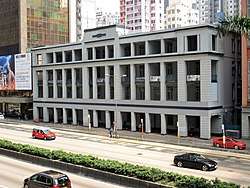 |
22.279248°N 114.175286°E | Built in 1932. A Grade III Historic Building. |
| Old Upper Levels Police Station | 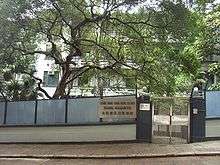 |
No. 1F High Street, Sai Ying Pun. |
Built in 1934-1935. It was later used as the Crime Hong Kong Island Regional Headquarters. Now part of the David Trench Rehabilitation Centre. A Grade III Historic Building. |
| Ta Kwu Ling Police Station | Ping Che Road, Ta Kwu Ling. |
Built in 1937. Still used as a police station. A Grade III Historic Building. | |
| Former Wan Chai Gap Police Station | 22.26765°N 114.169197°E | Built in 1939. Now housing the Hong Kong Police Museum. | |
| Former Lau Fau Shan Police Station | Lau Fau Shan.22.469035°N 113.983795°E | Built in 1962. Used until 2002.[4] Awaiting adaptive reuse. It has been proposed to be converted into a restaurant with exhibition space to reminisce the history of the oyster farming industry of Lau Fau Shan.[5] A Grade III Historic Building. | |
Demolished police stations
| Name | Photographs | Location | Notes/References |
|---|---|---|---|
| Old Sha Tin Police Station | 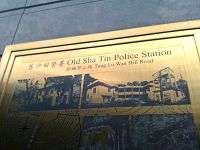 |
Tung Lo Wan Hill Road, Sha Tin District |
Demolished. Built in 1950 and demolished in 2004. After being decommissioned as a police station, it housed the Regional Continuation Training Centre.[6] It is now the site of The Great Hill private housing estate.[7] |
| Au Tau Police Station | 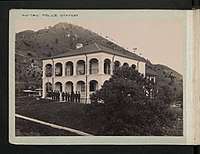 |
Au Tau, Yuen Long District |
Demolished. Built in 1900 and demolished in 1942.[8] |
| Starling Inlet Police Station | 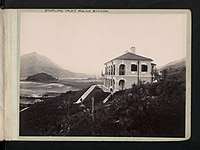 |
Sha Tau Kok, North District |
Demolished. Built in 1899 and demolished in 1942. The Sha Tau Kok Police Station now occupies the site.[9] |
Historic police quarters
| Name | Photographs | Location | Notes/References |
|---|---|---|---|
| Old Police Bungalow | Nos. 173 and 175 Kwong Fuk Road, Tai Po |
Built in 1909. The bungalow was the residence of four single police officers at the time when it was built. It is a Grade II historic building. | |
| Hollywood Road Police R & F Married Quarters | No. 35 Aberdeen Street, Central. |
Built in 1951.[10] | |
MacIntosh Forts
gollark: To go through a mere 1800ish things per frame?
gollark: Computers are fast, that's negligiblfikfkvlble.
gollark: Make an isometric game || 🐝.
gollark: Anyway, if I turn up the derivative term, it does that.
gollark: [REDACTED UNDER φ-152 PROTOCOLS]
References
- Lau, Stuart (23 November 2012). "Memories of a haven for Nationalists". South China Morning Post. Retrieved 9 January 2014.
- High Rock Centre: Former's High Rock and Today's High Rock
- List of the 1,444 Historic Buildings in Building Assessment (as of 27 December 2013)
- Lau Fau Shan Police Station at gwulo.com
- Ng, June (Mar 25, 2010). "Fishy Business". HK Magazine.
- Item for Public Works Subcommittee of Finance Committee, 17 April 2002
- "The Great Hill – former site of Old Shatin Police Station"
- Former Au Tau Police Station (1900-1942) at gwulo.com
- Former Starling Inlet Police Station (1899-1942) at gwulo.com
- Consultancy for Heritage Impact Assessment for Transformation of the Former Police Married Quarters Site on Hollywood Road into a Creative Industries Landmark. Volume 1 - Built Heritage Impact Assessment. Architectural Services Department. March 2011
This article is issued from Wikipedia. The text is licensed under Creative Commons - Attribution - Sharealike. Additional terms may apply for the media files.